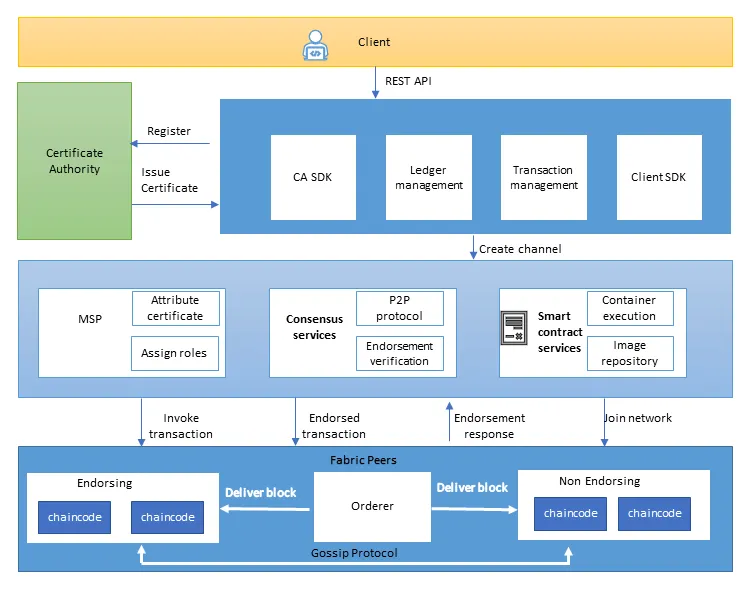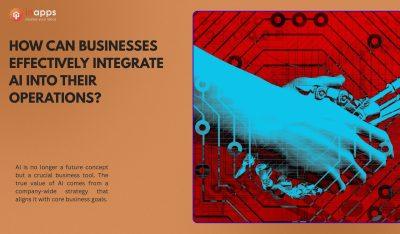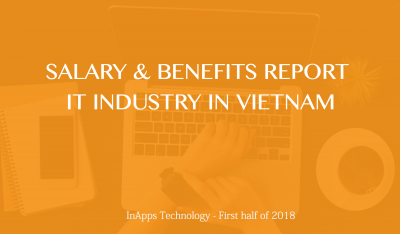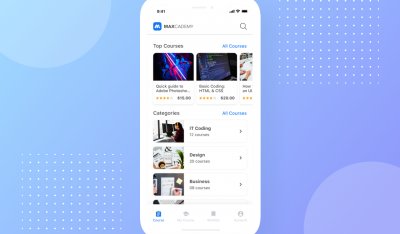- Home
- >
- Offshore News
- >
- How To Build a Blockchain App Successfully
Blockchain technology is more than just the backbone of cryptocurrencies; it represents a paradigm shift in how data is managed and secured across various sectors. According to a report by MarketsandMarkets, the worldwide blockchain market was valued at roughly $7.4 billion and is expected to expand to over $94.0 billion by 2027. This growth represents a compound annual growth rate (CAGR) of approximately 66.2% from 2022 to 2027.
If you’re an entrepreneur planning to build a blockchain app, it’s crucial to understand the different types and key functions of blockchain applications. This blog is designed to give you the knowledge you need to create your first blockchain app development. It will help you make smart choices about how to use this technology in your business.
1. What are blockchain apps?
Blockchain apps, or DApps, are a type of software that runs on a blockchain network. Unlike regular apps, which use a central system to store data, blockchain apps spread out the data across many computers. This setup makes them very secure and almost impossible to hack because no single point controls all the data.
When you build a blockchain app, you’re making an app that anyone on the network can use without worrying about the information being tampered with or lost. This is because once data is added to a blockchain, it can’t be changed or removed, which is a big deal for keeping things like financial transactions safe.
These apps are useful because they are open and transparent. Everyone involved can see the transactions and data, but at the same time, they can keep certain details private. This balance makes blockchain apps popular for things beyond just money, like voting systems or health records.
2. Type of blockchain apps
Blockchain apps, also known as decentralized applications (DApps), come in various forms, each designed to take advantage of the blockchain’s security and transparency. Here are some of the main types of blockchain apps you might encounter:
-
Financial Apps: These apps are the most common type when you build a blockchain app. They handle everything from money transfers to managing digital currencies like Bitcoin. This type of app is often used in decentralized finance, or DeFi, which lets people handle financial transactions without banks.
-
Smart Contracts: Smart contracts are like automatic agreements that execute themselves under certain conditions, directly on the blockchain. They are a core component when you build your first blockchain app because they cut out middlemen from various processes. This can include anything from releasing funds when work is completed, to confirming that someone owns something.
-
Supply Chain Trackers: These blockchain apps help companies track the journey of a product from manufacture to sale. They are crucial for ensuring that each step of the supply chain is verifiable and products are genuine, which is great for industries where authenticity and timing are critical.
-
Identity Verification Apps: With identity theft a big concern, blockchain can offer a more secure way to manage and verify personal identities online. These apps allow users to control their own data and share it securely with entities that need verification, reducing the risk of fraud.
-
Voting Systems: Blockchain-based voting apps provide a secure and transparent way of conducting elections. Since the data in a blockchain cannot be changed once entered, it ensures that votes are not tampered with, making the election process fairer and clear.
Each of these types uses blockchain to create solutions that are safe, open, and reliable, making them popular in areas far beyond just finance. Whether it’s your first time to build a blockchain app or you’re exploring new possibilities, understanding these types can help you see the vast potential of blockchain technology.
3. Considerations for building a blockchain app
When you set out to build a blockchain app, it’s important to consider several key factors to ensure its success and relevance.
Ensuring Blockchain is the Right Fit
First, clearly define the problem you’re solving. Blockchain technology is particularly suited for applications that require security, transparency, and data integrity. Make sure these are core needs in your project, as this clarity will streamline the process of creating a blockchain app.
Choosing the Right Platform
Choosing the right blockchain platform is another crucial step. For instance, Ethereum is well-suited for creating blockchain applications that involve complex smart contracts, whereas platforms like Hyperledger might be better for enterprise solutions that require privacy and scalability. Each platform has its strengths and limitations, so your choice should align with your app’s requirements.
Enhancing User Experience
User experience is also vital. Blockchain applications can often be less intuitive than traditional applications, primarily due to the complexities of blockchain technology. When you build app on blockchain, focus on designing a user interface that simplifies these complexities. Ensure that interactions with the blockchain are seamless and that users do not need to manage cryptographic keys or understand blockchain jargon to use the app effectively.
Security Measures
Security considerations are the next factor to consider in blockchain app development. While blockchain is inherently secure, applications built on top of it can have vulnerabilities, especially in smart contracts. Rigorous testing and auditing of the code are necessary to prevent exploits and breaches.
Navigating Regulatory Requirements
Last but not least, to make a blockchain app successful, you must consider the regulatory environment. Blockchain applications, especially those handling financial transactions or sensitive data, may be subject to specific regulations.
Before developing your blockchain app, you have to thoroughly research the regulatory requirements relevant to this niche in your area. Then, you can consult with legal experts in blockchain and financial law to find out how your blockchain apps can comply with these rules. Understanding these legal frameworks and ensuring compliance from the beginning can save you from legal challenges and fines in your efforts to build your first blockchain app.
By addressing these considerations—defining clear objectives, selecting the appropriate platform, prioritizing user experience, ensuring robust security, and navigating regulatory landscapes—you can create a blockchain app that not only meets but exceeds user and market expectations.
4. Tech stack for building a blockchain app
The tech stack for developing a blockchain application can significantly influence both the performance and success of your app. As you prepare to build your first blockchain app, consider each component’s role and how they integrate to create a robust, efficient, and secure application.
Frontend Development
When you build an app on blockchain, the frontend is your users’ primary point of interaction. It needs to be user-friendly and efficient, capable of interacting seamlessly with the blockchain. React.js is highly recommended because of its modularity and the reactive updates it offers. It allows for building a dynamic frontend that can easily update in response to backend changes without reloading the page.
Backend Development
The backend of a blockchain app manages the business logic and interacts directly with the blockchain. Node.js is a popular choice for backend development in blockchain applications due to its non-blocking I/O and event-driven architecture, which are ideal for handling numerous transactions that a blockchain application might require. It works efficiently in real-time environments where performance and scalability are crucial.
Learn more: Front End vs Back End Developer Salary: Who Gets Paid More?
Blockchain Network
Choosing the right blockchain platform is essential. Ethereum is one of the most common platforms for deploying smart contracts and DApps due to its mature environment and active community. However, alternatives like Binance Smart Chain or Solana may offer benefits such as lower transaction fees or faster processing times, which can be crucial depending on the application’s needs.
Smart Contracts
Smart contracts are pivotal in blockchain applications; they automate executions and enforce the rules of interaction within the app. Solidity is the primary language used for developing smart contracts on Ethereum. It’s designed specifically for creating and implementing smart contracts and is supported by a vast range of development tools and libraries, making it a reliable choice as you build blockchain apps.
Development and Testing Tools
For effective development and testing, the Truffle Suite offers a comprehensive development environment that includes testing frameworks and asset pipelines. Its component Ganache provides a personal blockchain you can use for testing purposes, allowing you to develop and test your applications in a safe, controlled environment. This is crucial for debugging before launching your app on the main network.
By selecting the right tools and technologies based on your specific needs, you can build a blockchain app that is not only functional but also scalable and secure. Each component of your tech stack should be chosen with consideration of how it will help achieve the goals of your blockchain application, ensuring a successful build and deployment.
5. How to Build a Blockchain App
Step 1: Define Your Objective and Requirements
When you start to develop blockchain applications, the very first step involves getting a clear understanding of what you want your app to achieve. Think about the problem you’re tackling. This isn’t just preliminary work; it’s the cornerstone of your entire project. Knowing exactly what functionalities to develop will ensure that your app resonates with your target audience.
Consider who will be using your app—this helps tailor the features and user experience effectively. For example, if your blockchain app is for healthcare professionals who need to store and access patient records quickly, you would design the app to include features like secure login, easy navigation for retrieving patient data, and automatic updates or notifications about patient status changes.
Also, keep any regulatory and compliance issues in mind, particularly if your app deals with sensitive data or financial transactions. This foundational step helps you create a targeted solution that genuinely resolves user pain points or introduces new efficiencies.
Step 2: Choose the Right Blockchain Platform
Choosing the right platform is critical when you’re ready to build a blockchain app. Each blockchain platform has unique attributes and is suited to different types of applications. Your choice will significantly impact the app’s scalability, security, and functionality.
If you’re looking at platforms like Ethereum, it offers broad support and a robust set of tools for developers. Meanwhile, Hyperledger could be preferable if you’re focusing on privacy and enterprise features. Consider the type of blockchain—public, private, or consortium—that will best meet your app’s requirements in terms of transparency, security, and user accessibility.
Step 3: Design the Architecture
Next up is designing your app’s architecture. Your app’s architecture should clearly outline how each component interacts, from user interfaces to backend logic and data storage. You’ll want to design a system where data flows smoothly between on-chain and off-chain environments and where smart contracts integrate seamlessly with the user interface. This well-thought-out foundation will support efficient operations and user interactions.
Here’s an example of the architecture of a blockchain app:

Design the blockchain app’s architecture. Source: ResearchGate
Step 4: Set Up Your Development Environment
Setting up a robust development environment is crucial for developing blockchain applications. This environment includes the tools and platforms where you will write, test, and deploy your code.
Step 5: Develop and Test Smart Contracts
Smart contracts are the backbone of any blockchain application. They automate operations and ensure that transactions are processed under specific conditions, so they must be both secure and efficient. You can consider developing these using a suitable programming language, such as Solidity for Ethereum-based apps. Rigorous testing with frameworks like Mocha ensures that your contracts perform correctly under all expected conditions. This makes your blockchain app both secure and functional, helping to prevent costly errors or security breaches
Step 6: Build the Frontend and Backend
The frontend is where users interact with your app, while the backend handles the app’s logic, database operations, and server-side functions. Both need to be efficiently developed and integrated to make blockchain app solutions functional and user-friendly.
Develop a user-friendly frontend with React.js, making sure it’s intuitive and responsive. The backend, built with Node.js, should robustly handle business logic and database operations. Ensure that these components communicate effectively, providing a seamless user experience and reliable functionality.
Step 7: Integrate and Test the Full System
Integration involves ensuring all individual parts of your blockchain app work together seamlessly. This step is crucial for the holistic functionality of your app.
After all parts are developed, integrate them to ensure they work harmoniously. This phase is critical—integration testing can uncover issues between the frontend, backend, and blockchain components that were not evident during individual testing. Solving these issues before deployment ensures your app functions smoothly.
Step 8: Deploy and Monitor
Once your app is tested and ready, the next step in building a blockchain app is to deploy it to a live blockchain. Continuous monitoring is crucial to maintain its performance and address any emerging issues.
Finally, deploy your blockchain app to the chosen blockchain platform. This step moves your project from a development setting to the real world, where actual users can interact with it. Monitoring the app continuously post-launch helps you quickly identify and rectify performance issues or bugs. This way, your application remains efficient and secure over time.
Wrap up
Let’s create the next big thing together!
Coming together is a beginning. Keeping together is progress. Working together is success.




















